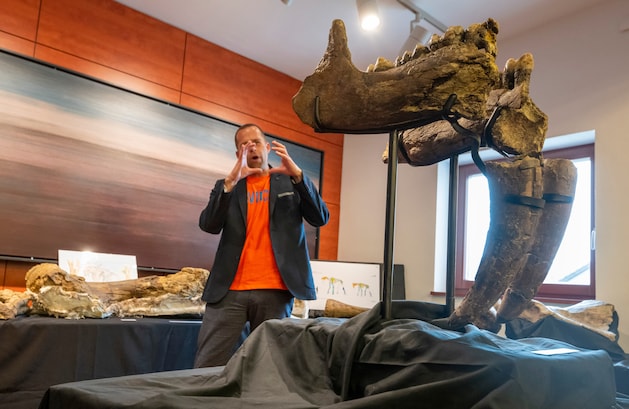It was the children of the museum director who first saw a bone sticking out of the ground: unusually well-preserved remains of ancient elephants were discovered in the Erding district near Munich.
The upper arm weighs 100 kilograms and the shoulder blade is almost one meter in diameter: the ancient elephants that lived in the Munich area over ten million years ago were huge. The unusually well-preserved remains of three animals were found in the Erding district and, according to experts, are a sensation due to the number of bones and their condition. On Monday, Peter Kapustin, director and founder of the Prehistoric Museum in Taufkirchen an der Vils, presented the find.
The animals, which weighed up to 13 tons and reached a shoulder height of over four meters, belonged to the genus Deinotherium and the species Deinotherium giganteum. The downward curved tusks of the lower jaw are characteristic of this genus. Most other genera of ancient elephants at that time even had four tusks, one pair at the bottom and one pair at the top.
Kapustin’s nine and ten year old sons discovered the first bone a year ago while searching for fossils with their father on a slope near a burrow.
There are now around 120 bones. These include the skull and tusks of a young animal that is 70 percent preserved. This is “spectacular,” says Gertrud Rößner, senior curator for fossil mammals at the Bavarian State Collection for Paleontology and Geology, who was involved in the assessment of the find. “We know that these ancient elephants lived here. But relatively complete skeletons are rare.”
Kapustin – a trained business economist and self-taught paleontologist – had been out and about in the area again and again. In 2004, the skull of a Deinotherium was discovered near Langenpreising. “For 20 years I kept making pilgrimages to the spot and thought: Maybe something else is coming – unfortunately it was always fruitless.” Until his children were found on April 13, 2023.
A months-long search then began with volunteers, which also uncovered the bones of a big cat and an ancient rhinoceros. A rhinoceros tooth is stuck on the vertebral process of an elephant. It is not the case that the rhinoceros hunted the elephant, but rather that the bones of the animals – including the cat – were probably washed up in the river at that time. “Such small mammal finds indicate very rapid embedding in the river sediments,” explained geologist Alexander Benn. Otherwise the bones would not have been preserved.
For the deinotheres, the largest land mammals in Europe, it is the largest site ever discovered, said the geological preparator, Nils Knötschke. He spoke of a stroke of luck for science. The second well-preserved animal was larger and older, but not yet fully grown, so that the development of the animals could be seen. A huge thigh bone was found from the third animal. After their finders, Kapustin’s sons, the two better-preserved animals were given the provisional names “Little Consti” and “Big Alex”.
In order to prevent the cracked and fragile bones from disintegrating, “liters of superglue” were used, reports Knötschke. “We had to prepare for the rescue in a bit of a tricky way. We didn’t want to destroy anything.” They were then recovered in a plaster coat.
It is unclear why the bones of the ancient elephants were all found in one place. It would be possible that, like today’s elephants, they went to a specific place to die and that it was therefore a prehistoric “elephant cemetery”, says senior curator Rößner, “but that cannot be answered with certainty”.
A relatively large number of remains of prehistoric elephants are known from Bavaria, around five of which are partial skeletons, including those from the Erdinger finds. What is outstanding is a gomphotherium discovered in 1971 near Mühldorf am Inn, almost complete with almost 200 bones, a replica of which is on display in the Bavarian State Collection.
However, Bavaria was not specifically an “elephant country”. In what is now the southern Free State, remains of the ancient elephants have been preserved comparatively well and close to the surface due to the favorable geological situation in the Molasse basin north of the Alps.
Between about 18 and 2.5 million years ago, numerous ancient elephants lived in what is now Europe. The species richness was far greater than that of today’s elephants. “Proboscideans were very diverse and widespread almost worldwide until the Ice Age,” says Rößner.
The cause of their extinction is likely to be due to climatic and associated ecological changes. There was no frost until 14 million years ago, when crocodiles and giant tortoises also lived in this country. “Then it gradually became cooler and drier.” The last genus of proboscideans in this country were the woolly mammoths until around 14,000 years ago.















